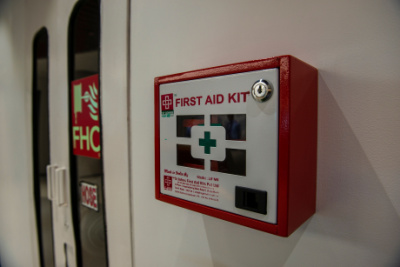Facilities managers should work with building management to ensure they have adequate first-aid kits and automated external defibrillator devices (AEDs) to comply with the law and minimum safety standards and, more importantly, for the safety of facility occupants.

The installation and maintenance of these units, along with associated signage, usually fall in the hands of facilities management.
In a medical emergency, occupants should call 911 and use first-aid or AED equipment, using the best practices of a workplace first-aid program, until medical help arrives.
Cardiac Arrests, Injuries, and Illnesses
According to the American Red Cross, more than 350,000 people suffer a cardiac arrest each year. The odds of survival are reduced by 10% per minute, and the average response time for first responders is 8 to 12 minutes. Quite simply, AEDs save lives.
The U.S. Bureau of Labor Statistics says 2.6 million nonfatal workplace injuries and illnesses were reported by private industry employers in 2021—the latest statistics available. First-aid kits can help with both common injuries and emergencies in facilities.
First-Aid Kit Compliance
The Occupational Safety and Health Administration (OSHA) has set legal requirements for workplace first-aid kits for logging, electric power generation, commercial diving, maritime, and construction.
Additionally, OSHA 29 Code of Federal Regulations (CFR) 1910.151 states that in the “absence of an infirmary, clinic, or hospital in/near proximity to the workplace which is used for the treatment of all injured employees, a person or persons shall be adequately trained to render first aid. Adequate first aid supplies should be readily available.”
The voluntary minimum performance specifications of first-aid kits are established by the American National Standards Institute (ANSI) and published by the International Safety Equipment Association (ISEA). The latest version is ANSI/ISEA Z308.1-2021.
Types of First-Aid Kits
Facilities professionals should install first-aid kits in hallways, in boxes mounted in break rooms, and in other central locations. Prices can vary based on type and class.
There are four types of first-aid containers:
- Type I: used in stationary indoor settings and mounted;
- Type II: meant for portable use indoors;
- Type III: designed for portable indoor and/or outdoor use, should have a water-resistant seal, and can be mounted; and
- Type IV: used in mobile industries and/or outdoor settings and can be mounted, as well as need to meet guidelines for corrosion, moisture, and resistance.
Class A First-Aid Kits
Class A first-aid kits are designed for the most common types of injuries.
They should include these 19 items:
- Adhesive bandages
- Adhesive tape
- Antibiotic application
- Antiseptic
- Breathing barrier
- Burn dressing
- Burn treatment
- Cold pack
- Eye covering
- Eye/skin wash
- First-aid guide
- Foil blanket
- Hand sanitizer
- Medical exam gloves
- Roller bandage
- Scissors
- Sterile pads
- Trauma pads
- Triangular bandages
Class B First-Aid Kits
ANSI recommends that for a broader range and quantity of supplies in more populated or high-risk work environments, Class B kits should be used, which have all Class A kit items in greater quantities and include a splint and tourniquet.
Why Install an AED Unit?
In addition to having a first-aid kit, your facilities should also have AED units. OSHA’s website states that AEDs are “an important lifesaving technology and may have a role to play in treating workplace cardiac arrest. Most sudden cardiac deaths occur outside of the hospital.”
What Do AED Units Do?
OSHA standards recommend, but don’t require, that facilities have AEDs, which are medical devices with battery and pad electrodes designed to analyze the heart rhythm and deliver an electric shock to victims of cardiac arrest to restore the heart’s normal rhythm, according to the U.S. Food and Drug Administration (FDA).
Types of AEDs
There are two main AED types:
- Professional use—used by first responders who receive AED training
- Public-access AEDs—found in a variety of places and intended to be used by those with minimal training
Facilities managers should take the American Heart Association’s advice and consider installing public-access AEDs in areas like sports arenas, office complexes, doctor’s offices, and shopping malls. Other places to consider include restaurants, gyms, hotels, schools, and places of worship.
Defibrillator Types
Additionally, according to the FDA, there are two types of AED defibrillators:
- Semiautomated defibrillators: These analyze the heart’s rhythm, and if an abnormal heart rhythm is detected, the device asks the user to press a button to deliver the shock.
- Fully automated defibrillators: These analyze the heart’s rhythm and deliver a defibrillation shock if commanded by the device software without user intervention.
Compliance
Facilities managers should ensure their AED units and accessories are FDA-approved by checking the FDA website and transition to an FDA-approved unit if they aren’t.
Learn More
Management should consider offering formal training in their facilities by the American Red Cross, the American Heart Association, or other organizations so workers can safely administer first aid and AED to colleagues and customers.
To learn more, check out “First-Aid Kits: Update Yours to Meet New Industry Standard” on EHS Daily Advisor, “Back to Basics: Workplace Medical and First Aid” on EHS Daily Advisor, and “Having AED at Your Workplace Can Save Lives, Shield You from Liability” on HR Daily Advisor.
